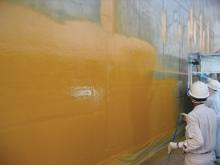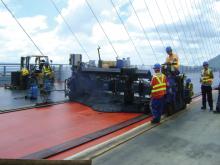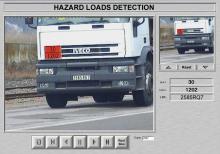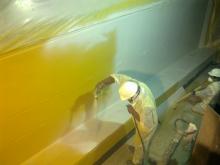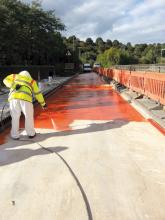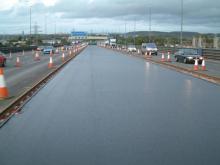With traffic volumes increasing around the world, many existing road links will need to be upgraded or replaced in coming years The need for new road tunnels is particularly intense in many dense urban areas, due to environmental requirements that mean new road links will have to be installed underground. However, improving existing road tunnel links is providing a very large part of the business for this specialised construction segment at present.
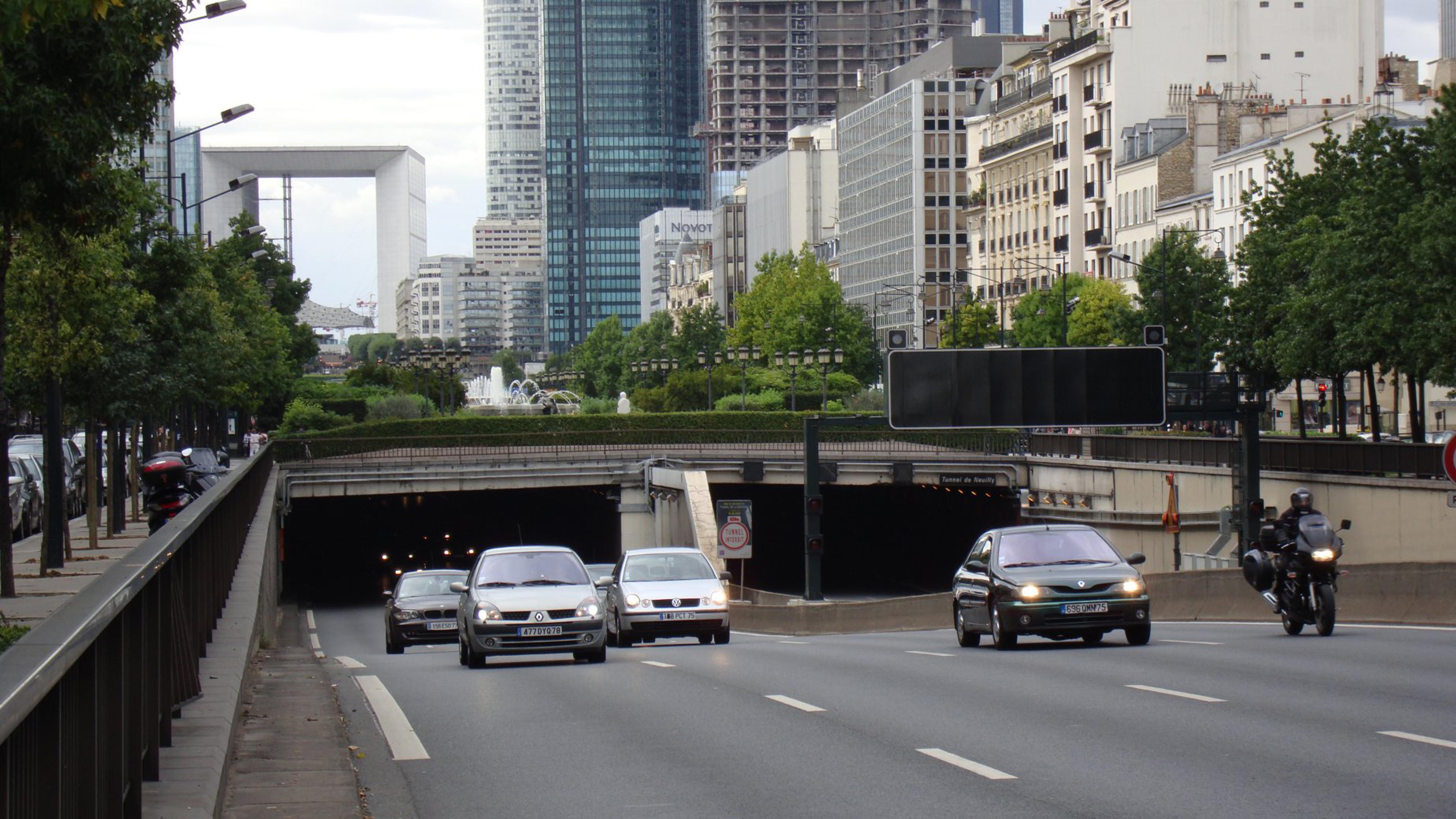
With traffic volumes increasing around the world, many existing road links will need to be upgraded or replaced in coming years
The need for new road tunnels is particularly intense in many dense urban areas, due to environmental requirements that mean new road links will have to be installed underground.
However, improving existing road tunnel links is providing a very large part of the business for this specialised construction segment at present.
In Europe, tunnel safety has been set as a priority following a number of major disasters in road links. New highway tunnel regulations were introduced to deal with the issues, which has resulted in an array of projects to upgrade existing links.
348 Traficon is working on a major project at present designed to boost safety and is installing its sophisticated automatic incident detection (AID) system in 22 road tunnels around French capital Paris. The contract has been awarded by the Direction Inter-Départementale des Routes d'Ile-de-France (DIRIF) and this is the largest tunnel surveillance project of its type ever implemented in the world. Over the next three years, 1,400 cameras linked to Traficon's Automatic Incident Detection (AID) system will be installed to monitor traffic using the Paris Region's tunnels.
This advanced camera-based technology offers a fast detection rate in combination with direct visual feedback according to Traficon. The system warns an operator about any abnormal traffic behaviour inside the tunnel and can quickly launch all necessary steps to prevent an incident from escalating into a major disaster.
This move is being made as French regulations now require tunnel safety to be brought up to the highest available security standards. Every tunnel longer than 300m has to be equipped with an AID system to be able to detect all major incidents within seconds. This includes events such as stationary vehicles, smoke, traffic congestion, wrong-way drivers, pedestrians and fallen objects. Traficon and its partners Sdel, Satelec, Clemessy and Fareco, believe the project will make the Paris Region tunnels the safest in the world.
The technology is already well-proven with more than 700 VIP-T incident detection boards installed in 32 tunnels spread throughout and Traficon says that the module will deliver the high-level performance detection requirements of the project. This is a large-scale tunnel modernisation project however and is being carried out in eight phases, requiring an investment of €600 million over five years. At present the consortium carrying out the work is finishing the first stage comprising the A86, A14 La Défense and Neuilly tunnel complex.
Also designed for this market, the new and more capable package from D-Tec helps boost tunnel safety. Based on the proven FireVu video smoke detection (VSD) system this new package offers both CCTV-based smoke and flame detection in tunnels. Key changes have been built into the new model of the NetVu Connected FireVu, which combines VSD with video over IP, for improved performance and ease of installation. Notable upgrades include an advanced flame detection algorithm and new smoke detection algorithms that also benefit from the increased performance of the unit's chipset.
As well as the internal changes, the new 8 channel system, which supports 24 outputs, comes in a much slimmer unit. A tailored engineering interface should simplify the commissioning process and this will also ease maintenance while system updates can be provided using the USB port.
According to the firm, this new system allows a layered response, providing an initial alarm for smoke and confirming if fire appears. In addition, the more advanced chip architecture and improved detection algorithms should make the latest unit's response to incidents faster and more accurate than before.
Tunnel safety systems are not the only important issue for road links however and ensuring structures are properly watertight is also vital. The 25km² Yas Island is a major development in Abu Dhabi and is gearing up for its Formula 1 debut this November at the brand new Yas Marina Race Circuit. The new Southern Crossing Tunnel forms a key link between Al Raha Beach and the Yas Marina Circuit.
Stirling Lloyd's advanced waterproofing membrane Integritank (see also World Highways, May 2009) is being used to protect the tunnel. To demonstrate Integritank,2314 Stirling Lloyd took representatives of Aldar and 2808 Taisei, the main contractor for the Southern Crossing Tunnel, to visit the New Doha International Airport in Qatar. Integritank was shown being applied with backfill placed directly against the cured membrane for waterproofing purposes. The application was carried out in hot, windy conditions surrounded by dust and sand, showing how the product was suitable for the Yas Island Tunnel project due to its similar environment.
Construction of the cast in-situ cut-and-cover Yas Island tunnel began in October 2008 while Stirling Lloyd's contractor, Advanced Specialist Treatment Engineering Ltd (ASTEL), arrived on site in the following month. Because of the tight time schedule, Integritank's working properties have been extremely beneficial. The advanced methylmethacrylate (MMA) based resin used produces a strong bond, even when applied in stages. The system can be quickly spray applied, which combined with its fast curing allows high productivity. Hot and humid weather can cause problems for installation of other liquid applied systems. However MMA resins can be applied despite temperatures in excess of 40°C and the high humidity experienced during construction.
In total some 49,000m2 of the Integritank system is being used on the 1.2km long, 40m wide tunnel. Tensile adhesion tests have been carried out on each section of tunnel to assess the bond strengths the system would achieve. To install the Integritank, the concrete substrate is primed with a primer which improves the adhesion of the membrane. Once the primer has cured, the first coat of Integritank is sprayed on and allowed to cure before the second coat is applied. To prevent errors the coats are coloured so that the sprayer can visually check that sufficient material has been applied. As Integritank is thixotropic it follows the contours of the substrate, leaving no weak spots where water can penetrate. Integrity tests are also carried out on each section after the material is applied to identify any potential problem areas.
When the tunnel is complete the cofferdam keeping water out from the construction bay will be removed and the tunnel will be submerged. The Integritank membrane will be left exposed and subject to significant pressure but Stirling Lloyd is confident of the application as the proven system is durable and also provides chemical resistance to the seawater and chemicals present in the waters surrounding the tunnel.
Along with the Integritank waterproofing solution for immersed tube and cut and cover tunnels, Stirling Lloyd is now offering Integritank HF. This product has been eight years in development and is designed for lining tunnels constructed using the new Austrian tunnelling method (NATM) that feature sprayed concrete linings. The material is said to offer a strong bond to the primary concrete and can withstand the sprayed application of the secondary lining.
Inspecting tunnel links is another important task calling for specialised machines. At Miltenberg in Germany a contractor has used a TUA 1.600T access platform from WEMO-tec to carry out fast tunnel inspection work on a new 350m tunnel being built. The link forms part of the ring road around Miltenberg and built by contractor Max Bögl, based in Neumarkt. The ring road has been built under a 25-year PPP deal that covers the construction and maintenance of roads and civil engineering structures in the area. The 4.8km ring road has an estimated cost of €48 million while the tunnel was built on an open-cut construction method at Miltenberg-North and cost €3.7 million.
The self-propelled platform features three special baskets and was able to achieve higher productivity than conventional machines.
Another issue that has to be dealt with is improving the road surface, which can become very dilapidated through heavy wear in some older tunnels. POLY-CARB is offering a versatile tunnel repair solution in the shape of its FLEXOGRID system, which can be used in an array of applications and can cope with tough environmental factors such as water, salt, weather and wear. At the Bankhead Tunnel in Mobile, Alabama, FLEXOGRID has been used successfully to upgrade the structure.
The Bankhead Tunnel was built from 1938-1940 and heavy use has resulted in the road surface wearing smooth and becoming bumpy in some spots. This deck surface is suspended with air flowing underneath, so it has similar characteristics to those of a bridge deck and POLY-CARB suggested FLEXOGRID as being suitable for this application. The narrow tunnel limits traffic flow to only cars and pick-up trucks however, so bringing in the large tractor trailer required for the FLEXOGRID installation was tricky. The towed FLEXOGRID equipment mixes, meters and dispenses material at controlled temperatures and allows it to cover over 3,048m²/hour.
Despite the tough requirements of the job, the thin and lightweight, yet tough and flexible FLEXOGRID system is said to offer long-term performance, while it can also be applied quickly. The POLY-CARB team also managed to install the system, despite the limitations posed by the tunnel dimensions. Even with a tunnel clearance height of 3.77m, the FLEXOGRID team managed to fit the 4m machine into the tunnel and also made additional modifications to its components so that the proprietary system would spread the aggregate in the confined space. While this process required a full working day to get into the tunnel and a half a day to get out, the FLEXOGRID team was able to meet the demands of the Alabama DOT and complete this job only during the weekends as specified.
The need for new road tunnels is particularly intense in many dense urban areas, due to environmental requirements that mean new road links will have to be installed underground.
However, improving existing road tunnel links is providing a very large part of the business for this specialised construction segment at present.
In Europe, tunnel safety has been set as a priority following a number of major disasters in road links. New highway tunnel regulations were introduced to deal with the issues, which has resulted in an array of projects to upgrade existing links.
This advanced camera-based technology offers a fast detection rate in combination with direct visual feedback according to Traficon. The system warns an operator about any abnormal traffic behaviour inside the tunnel and can quickly launch all necessary steps to prevent an incident from escalating into a major disaster.
This move is being made as French regulations now require tunnel safety to be brought up to the highest available security standards. Every tunnel longer than 300m has to be equipped with an AID system to be able to detect all major incidents within seconds. This includes events such as stationary vehicles, smoke, traffic congestion, wrong-way drivers, pedestrians and fallen objects. Traficon and its partners Sdel, Satelec, Clemessy and Fareco, believe the project will make the Paris Region tunnels the safest in the world.
The technology is already well-proven with more than 700 VIP-T incident detection boards installed in 32 tunnels spread throughout and Traficon says that the module will deliver the high-level performance detection requirements of the project. This is a large-scale tunnel modernisation project however and is being carried out in eight phases, requiring an investment of €600 million over five years. At present the consortium carrying out the work is finishing the first stage comprising the A86, A14 La Défense and Neuilly tunnel complex.
Also designed for this market, the new and more capable package from D-Tec helps boost tunnel safety. Based on the proven FireVu video smoke detection (VSD) system this new package offers both CCTV-based smoke and flame detection in tunnels. Key changes have been built into the new model of the NetVu Connected FireVu, which combines VSD with video over IP, for improved performance and ease of installation. Notable upgrades include an advanced flame detection algorithm and new smoke detection algorithms that also benefit from the increased performance of the unit's chipset.
As well as the internal changes, the new 8 channel system, which supports 24 outputs, comes in a much slimmer unit. A tailored engineering interface should simplify the commissioning process and this will also ease maintenance while system updates can be provided using the USB port.
According to the firm, this new system allows a layered response, providing an initial alarm for smoke and confirming if fire appears. In addition, the more advanced chip architecture and improved detection algorithms should make the latest unit's response to incidents faster and more accurate than before.
Tunnel safety systems are not the only important issue for road links however and ensuring structures are properly watertight is also vital. The 25km² Yas Island is a major development in Abu Dhabi and is gearing up for its Formula 1 debut this November at the brand new Yas Marina Race Circuit. The new Southern Crossing Tunnel forms a key link between Al Raha Beach and the Yas Marina Circuit.
Stirling Lloyd's advanced waterproofing membrane Integritank (see also World Highways, May 2009) is being used to protect the tunnel. To demonstrate Integritank,
Construction of the cast in-situ cut-and-cover Yas Island tunnel began in October 2008 while Stirling Lloyd's contractor, Advanced Specialist Treatment Engineering Ltd (ASTEL), arrived on site in the following month. Because of the tight time schedule, Integritank's working properties have been extremely beneficial. The advanced methylmethacrylate (MMA) based resin used produces a strong bond, even when applied in stages. The system can be quickly spray applied, which combined with its fast curing allows high productivity. Hot and humid weather can cause problems for installation of other liquid applied systems. However MMA resins can be applied despite temperatures in excess of 40°C and the high humidity experienced during construction.
In total some 49,000m2 of the Integritank system is being used on the 1.2km long, 40m wide tunnel. Tensile adhesion tests have been carried out on each section of tunnel to assess the bond strengths the system would achieve. To install the Integritank, the concrete substrate is primed with a primer which improves the adhesion of the membrane. Once the primer has cured, the first coat of Integritank is sprayed on and allowed to cure before the second coat is applied. To prevent errors the coats are coloured so that the sprayer can visually check that sufficient material has been applied. As Integritank is thixotropic it follows the contours of the substrate, leaving no weak spots where water can penetrate. Integrity tests are also carried out on each section after the material is applied to identify any potential problem areas.
When the tunnel is complete the cofferdam keeping water out from the construction bay will be removed and the tunnel will be submerged. The Integritank membrane will be left exposed and subject to significant pressure but Stirling Lloyd is confident of the application as the proven system is durable and also provides chemical resistance to the seawater and chemicals present in the waters surrounding the tunnel.
Along with the Integritank waterproofing solution for immersed tube and cut and cover tunnels, Stirling Lloyd is now offering Integritank HF. This product has been eight years in development and is designed for lining tunnels constructed using the new Austrian tunnelling method (NATM) that feature sprayed concrete linings. The material is said to offer a strong bond to the primary concrete and can withstand the sprayed application of the secondary lining.
Inspecting tunnel links is another important task calling for specialised machines. At Miltenberg in Germany a contractor has used a TUA 1.600T access platform from WEMO-tec to carry out fast tunnel inspection work on a new 350m tunnel being built. The link forms part of the ring road around Miltenberg and built by contractor Max Bögl, based in Neumarkt. The ring road has been built under a 25-year PPP deal that covers the construction and maintenance of roads and civil engineering structures in the area. The 4.8km ring road has an estimated cost of €48 million while the tunnel was built on an open-cut construction method at Miltenberg-North and cost €3.7 million.
The self-propelled platform features three special baskets and was able to achieve higher productivity than conventional machines.
Another issue that has to be dealt with is improving the road surface, which can become very dilapidated through heavy wear in some older tunnels. POLY-CARB is offering a versatile tunnel repair solution in the shape of its FLEXOGRID system, which can be used in an array of applications and can cope with tough environmental factors such as water, salt, weather and wear. At the Bankhead Tunnel in Mobile, Alabama, FLEXOGRID has been used successfully to upgrade the structure.
The Bankhead Tunnel was built from 1938-1940 and heavy use has resulted in the road surface wearing smooth and becoming bumpy in some spots. This deck surface is suspended with air flowing underneath, so it has similar characteristics to those of a bridge deck and POLY-CARB suggested FLEXOGRID as being suitable for this application. The narrow tunnel limits traffic flow to only cars and pick-up trucks however, so bringing in the large tractor trailer required for the FLEXOGRID installation was tricky. The towed FLEXOGRID equipment mixes, meters and dispenses material at controlled temperatures and allows it to cover over 3,048m²/hour.
Despite the tough requirements of the job, the thin and lightweight, yet tough and flexible FLEXOGRID system is said to offer long-term performance, while it can also be applied quickly. The POLY-CARB team also managed to install the system, despite the limitations posed by the tunnel dimensions. Even with a tunnel clearance height of 3.77m, the FLEXOGRID team managed to fit the 4m machine into the tunnel and also made additional modifications to its components so that the proprietary system would spread the aggregate in the confined space. While this process required a full working day to get into the tunnel and a half a day to get out, the FLEXOGRID team was able to meet the demands of the Alabama DOT and complete this job only during the weekends as specified.

